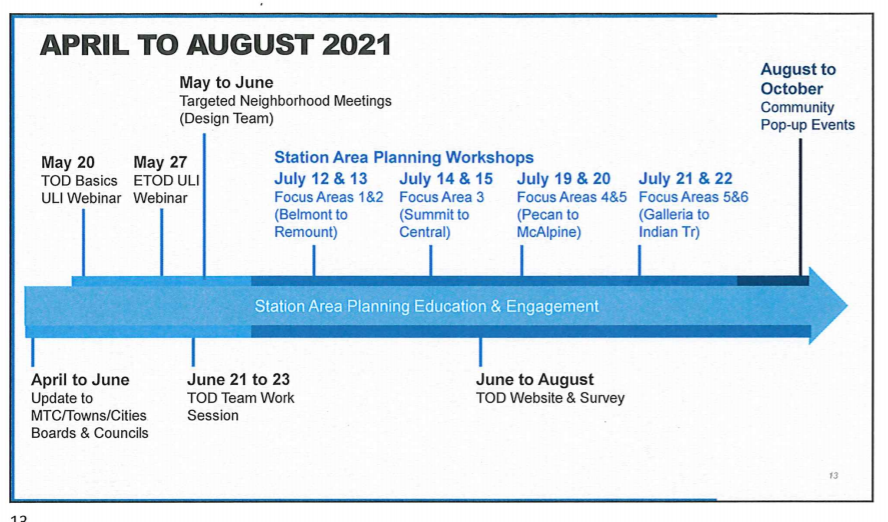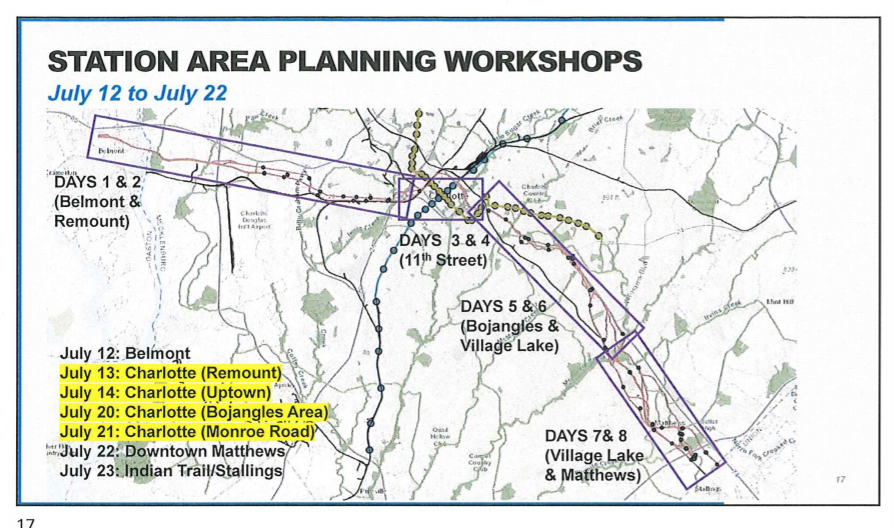City to begin land use planning around future Silver Line light rail
The Charlotte Area Transit System (CATS) is taking a look at Transit Oriented Development (TOD) along the proposed Lynx Silver Line. TOD is essentially the economic development that occurs adjacent to a high-frequency public transit line–in this case, the Silver Line light rail. For the past year and a half, the Silver Line team has worked to define the Locally Preferred Alternative including station areas. Now, CATS is focusing on planning TOD along the alignment.
Planning for development at light rail stations is extremely important. CATS started its TOD study in June 2020, and is now diving into its station area planning process as well as engaging the public and educating the public about TOD. This process is scheduled to last through July 2021.
CATS will engage the public in Station Area Planning workshops throughout the month of July.

Image: CATS
The workshops will occur in this sequence:
- July 12th and 13th, Focus Areas One and Two, Belmont to Remont
- July 14th and 15th, Focus Area Three, Summit to Central
- July 19th and 20th, Focus Areas Four and Five, Pecan to McAlpine
- July 21st and 22nd, Focus Areas Five and Six, Galleria to Indian Trail
These workshops are an excellent way to give feedback on TOD along the future Silver Line and will be advertised two weeks in advance.

Image: CATS
CATS will launch a TOD website on June 22nd to also assist with the public engagement process: www.cltsilverline.com. This website will include public engagement opportunities and further information about the Silver Line.
Why is Transit Oriented Development such an important focus?
The manner in which planners plan for economic development at station areas along the Silver Line could affect the entire landscape of a neighborhood. In particular, retail and residential development could bloom along the Silver Line. The Lynx Blue Line saw a mountain of economic development along its path. At the time, land was not set aside for affordable housing, so now the residential rents along the Lynx Blue Line are quite high and there is very little affordable or workforce housing being added.
This is the type of situation that the Silver Line planners want to understand so that housing equity can be prioritized. They want to understand the extent of need for affordable housing and choose recommended strategies to ensure that people of all income levels can afford to live within walking distance of the Silver Line. Bike and pedestrian connectivity and open space needs along the Blue Line Extension were not optimized. This is why CATS is studying station locations along the Silver Line with great potential for TOD and considering more factors beforehand.

Image: CharlotteUDO.org
CATS TOD planners also want to make a detailed analysis of certain stations along the Silver Line alignment that need more scrutiny when it comes to TOD. This means studying what to preserve and also what could possibly change at certain station areas. With a focus on the future, land use and zoning along Lynx Silver Line station areas could be maximized. This will require considerations in engineering, urban design, pedestrian and station safety, and equity and inclusionary practices.
Good TOD planning maximizes the public benefits of investment in transit. Light rail lines are expensive to build. The land around them should provide ample opportunities for residents to benefit from improved connectivity, mobility, and transportation affordabiility. TOD reduces over-reliance on automobiles by supporting walking and biking access to transit stations and the surrounding community’s amenities. This is all about smart growth, the heart of Sustain Charlotte’s mission!
How you can get involved:
Mark your calendar to attend one or more of CATS’s public meetings mentioned above. The registration will be available after the Silver Line site goes live on June 22nd. Let the planners know that affordable housing and active transportation opportunities for biking and walking along the Silver Line are issues that matter to you!
Thanks for reading!
As a nonprofit, community support is essential for us to keep doing what we do — including providing free articles like this. If you found this article helpful, please consider supporting Sustain Charlotte.
Want to stay in the loop? Subscribe to our weekly newsletter and follow us on Instagram, Facebook, and Twitter.
